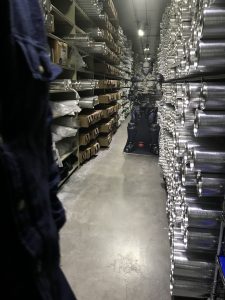DENVER – Scientists studying ancient air trapped in ice cores in the federal government’s minus-40 freezer say there’s no doubt human air pollution is causing global climate change.
But U.S. politicians, especially at the federal level, are failing to lead the shift away from fossil fuels that scientists say is necessary to avoid environmental catastrophe.
“It drives me crazy,” says Richard Nuun, assistant curator of the National Science Foundation Ice Core Facility, located at the U. S. Geological Survey’s regional headquarters, west of Denver.
“The political debate is about three steps behind.”

Ice cores line the walls of the National Ice Core freezer. Photo Heather Rolph
Ice cores provide some of the most definitive proof scientists have of climate change. Ice cores stored in the Denver facility and elsewhere give a glimpse of Earth’s climate over the past 800,000 years. Scientists from universities around the world measure concentrations of heat-trapping greenhouse gases in the ancient atmosphere, like carbon dioxide, along with temperature – data that they can compare to the current day.
Around 1870 at the start of the industrial revolution, carbon dioxide levels hovered around 280 parts per million. Now, they’ve reached 410 ppm.
Carbon dioxide levels were last this high over eight million years ago, according to ice core analysis combined with scientific research on ocean sediment. They reached 1,000 ppm during the Cretaceous period, 66 million years ago, long before humans existed. Scientists from the University of Missouri recently have released predictions that carbon dioxide levels will hit 600 ppm by the end of this century if emission rates continue on their current trajectory.
Yet global energy consumption is increasing as more people burn fossil fuels.
Instead of shifting as fast as possible to cleaner sources of energy, as the United Nations-backed scientific Intergovernmental Panel on Climate Change (IPCC) recommended with urgency in its latest report, the oil and gas industry is extracting fuel anywhere it can do so profitably.
On Colorado’s heavily populated Front Range, oil and gas companies are intent on buying the mineral rights to vast tracts of land. In Weld County, just north of the nation’s ice core lab in Denver, fossil fuel companies are installing heavy industrial facilities within 500 feet of houses in a rush to use new technologies of horizontal fracking to tap into natural gas reserves with the greatest efficiency.
In the town of Erie, situated between Boulder and Weld counties, uniformly brightly painted houses line the streets. But amid the booming housing developments, oil rigs protrude from the skyline.
On the edges of the town, where rows of houses give way to farmfields, the oil rigs are more plentiful. Natural gas, which produces less than half the carbon dioxide emissions when burned than coal and a quarter less than diesel or gasoline, has been thought of as a “bridge fuel” to smooth the transition from fossil fuels to renewable energy.
Some Colorado Front Range residents, including many in Erie, vehemently oppose oil and gas drilling in their towns. They’re frustrated with state regulations that favor oil and gas companies over private citizens.
“We were just living our life,” says resident Amanda Harper, a tall woman with a messy beehive of blonde hair and billowing brown pants, who has fought against oil and gas ever since drilling sites opened without her knowledge within a mile of her family’s house and farmland.
“We were going to get old here,” she says.
Erie town councilman Christiaan van Woudenberg, an anti-fracking activist, also lives near an industrial drilling site.
“I haven’t opened my windows in two years,” he says.
The diesel-like smell from the oil rigs, in addition to noise and bright lights, make his neighborhood a difficult place to live, he said. He’s dubious that natural gas is as much of a “bridge fuel” as has been claimed, citing the large quantities of methane that can escape during the drilling process. With two young daughters, he’s also concerned about the health impacts of benzene, a component of natural gas that is a known carcinogen. While there haven’t been conclusive studies on the health effects of growing up next to drilling sites, “until you can prove to me it’s safe, don’t do it,” van Woudenberg says.
It may be impossible to push oil and gas completely out of Colorado, as residents like Harper say they want. But with residents and local government officials raising concerns, and the Proposition 112 oil and gas setbacks measure on the Nov. 6th election ballot, the regulatory landscape for industry may be changing. Residents say they’re hopeful.
“If you don’t try, you’ve already lost,” van Woudenberg says.
This is a sentiment Nuun, back in the ice core freezer, echoes. He’s a tall, slightly stooped man with a wispy mustache and a beanie pulled low over his forehead. Both cheerful and talkative, he’s also deeply concerned about climate change and what he sees as a misguided lack of action.
“I think humanity’s going to figure it out,” he says. “Contact your elected officials and tell them to actually understand the science.”


